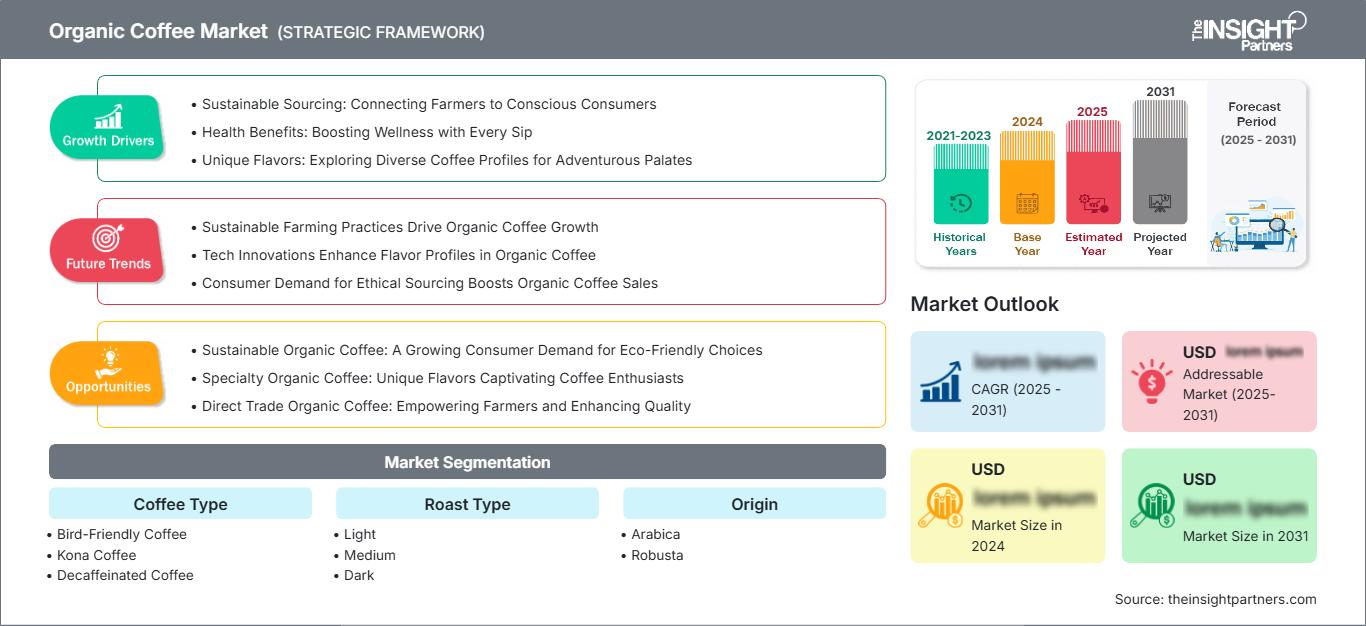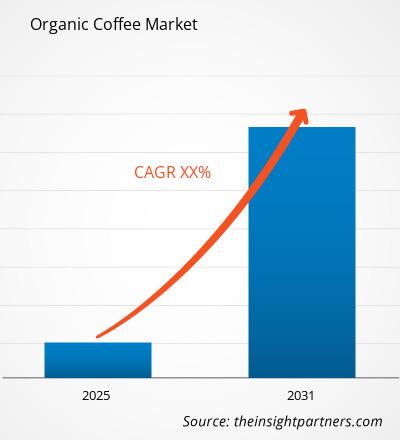Se espera que el mercado del café orgánico registre una CAGR del XX% entre 2025 y 2031, con un tamaño de mercado que se expandirá de US$ XX millones en 2024 a US$ XX millones en 2031.
El informe se clasifica por tipo de café (café apto para aves, café Kona, café descafeinado, café verde) y analiza el mercado en profundidad según el tipo de tueste (claro, medio, oscuro). También examina el mercado por origen (Arábica, Robusta) y tipo de sabor (chocolate y caramelo, cítrico y floral, almendra, amaretto, vainilla francesa, canela). Se proporciona un desglose completo a nivel global, regional y nacional para cada uno de estos segmentos clave.
El informe incluye el tamaño del mercado y las previsiones para todos los segmentos, con valores en USD. También ofrece estadísticas clave sobre el estado actual del mercado de los principales actores, junto con información sobre las tendencias actuales del mercado y las oportunidades emergentes.
Propósito del Informe
El informe "Mercado del Café Orgánico" de The Insight Partners busca describir el panorama actual y el crecimiento futuro, los principales factores impulsores, los desafíos y las oportunidades. Esto proporcionará información a diversas partes interesadas del negocio, como:
- Proveedores/fabricantes de tecnología: Para comprender la dinámica cambiante del mercado y conocer las oportunidades potenciales de crecimiento, lo que les permitirá tomar decisiones estratégicas informadas.
- Inversores: Realizar un análisis exhaustivo de tendencias respecto a la tasa de crecimiento del mercado, las proyecciones financieras del mercado y las oportunidades que existen en toda la cadena de valor.
- Órganos reguladores: Regular las políticas y las actividades policiales en el mercado con el objetivo de minimizar el abuso, preservar la confianza de los inversores y defender la integridad y estabilidad del mercado.
Segmentación del mercado del café orgánico
Tipo de café
- Café apto para aves
- Café Kona
- Café descafeinado
- Café verde
Tipo de asado
- Luz
- Medio
- Oscuro
Origen
- Arábica
- Robusta
Tipo de sabor
- Chocolate y caramelo
- Cítricos y florales
- Almendra
- Amaretto
- Vainilla francesa
- Canela
Obtendrá personalización en cualquier informe, sin cargo, incluidas partes de este informe o análisis a nivel de país, paquete de datos de Excel, así como también grandes ofertas y descuentos para empresas emergentes y universidades.
Mercado del café orgánico: Perspectivas estratégicas

- Obtenga las principales tendencias clave del mercado de este informe.Esta muestra GRATUITA incluye análisis de datos, desde tendencias del mercado hasta estimaciones y pronósticos.
Factores que impulsan el crecimiento del mercado del café orgánico
- Abastecimiento sostenible: conectando a agricultores con consumidores conscientes
- Beneficios para la salud: Mejore su bienestar con cada sorbo
- Sabores únicos: Explorando diversos perfiles de café para paladares aventureros
Tendencias futuras del mercado del café orgánico
- Las prácticas agrícolas sostenibles impulsan el crecimiento del café orgánico.
- Las innovaciones tecnológicas mejoran los perfiles de sabor del café orgánico.
- La demanda de los consumidores de abastecimiento ético impulsa las ventas de café orgánico
Oportunidades del mercado del café orgánico
- Café orgánico sostenible: una creciente demanda de opciones ecológicas por parte de los consumidores
- Café orgánico de especialidad: sabores únicos que cautivan a los amantes del café
- Café orgánico de comercio directo: empoderando a los agricultores y mejorando la calidad
Perspectivas regionales del mercado del café orgánico
Los analistas de The Insight Partners han explicado detalladamente las tendencias regionales y los factores que influyen en el mercado del café orgánico durante el período de pronóstico. Esta sección también analiza los segmentos y la geografía del mercado del café orgánico en Norteamérica, Europa, Asia Pacífico, Oriente Medio y África, y Sudamérica y Centroamérica.
Alcance del informe del mercado del café orgánico
| Atributo del informe | Detalles |
|---|---|
| Tamaño del mercado en 2024 | US$ XX millones |
| Tamaño del mercado en 2031 | US$ XX millones |
| CAGR global (2025-2031) | XX% |
| Datos históricos | 2021-2023 |
| Período de pronóstico | 2025-2031 |
| Segmentos cubiertos | Por tipo de café
|
| Regiones y países cubiertos | América del norte
|
| Líderes del mercado y perfiles de empresas clave |
|
Densidad de actores del mercado del café orgánico: comprensión de su impacto en la dinámica empresarial
El mercado del café orgánico está creciendo rápidamente, impulsado por la creciente demanda del consumidor final debido a factores como la evolución de las preferencias del consumidor, los avances tecnológicos y un mayor conocimiento de los beneficios del producto. A medida que aumenta la demanda, las empresas amplían su oferta, innovan para satisfacer las necesidades del consumidor y aprovechan las tendencias emergentes, lo que impulsa aún más el crecimiento del mercado.

- Obtenga una descripción general de los principales actores clave del mercado del café orgánico
Puntos clave de venta
- Cobertura integral: el informe cubre exhaustivamente el análisis de productos, servicios, tipos y usuarios finales del mercado de café orgánico, proporcionando un panorama holístico.
- Análisis de expertos: el informe se compila con base en el conocimiento profundo de expertos y analistas de la industria.
- Información actualizada: El informe asegura relevancia comercial debido a su cobertura de información reciente y tendencias de datos.
- Opciones de personalización: este informe se puede personalizar para satisfacer los requisitos específicos del cliente y adaptarse adecuadamente a las estrategias comerciales.
Por lo tanto, el informe de investigación sobre el mercado del café orgánico puede ayudar a descifrar y comprender el panorama de la industria y sus perspectivas de crecimiento. Si bien existen algunas preocupaciones válidas, las ventajas generales de este informe suelen superar las desventajas.
- Análisis histórico (2 años), año base, pronóstico (7 años) con CAGR
- Análisis PEST y FODA
- Tamaño del mercado, valor/volumen: global, regional y nacional
- Industria y panorama competitivo
- Conjunto de datos de Excel
Informes recientes
Informes relacionados
Testimonios
Razón para comprar
- Toma de decisiones informada
- Comprensión de la dinámica del mercado
- Análisis competitivo
- Información sobre clientes
- Pronósticos del mercado
- Mitigación de riesgos
- Planificación estratégica
- Justificación de la inversión
- Identificación de mercados emergentes
- Mejora de las estrategias de marketing
- Impulso de la eficiencia operativa
- Alineación con las tendencias regulatorias




















 Obtenga una muestra gratuita para - Mercado de café orgánico
Obtenga una muestra gratuita para - Mercado de café orgánico